Strength training—also known as weight or resistance training—is a key component of any fitness plan. It helps increase your strength and builds muscular endurance.
In strength training you move your body against some form of resistance, such as:
- your own body weight
- free weights, like dumbbells or barbells
- resistance bands, sometimes called tubing or workout bands
- resistance machines, for example cable stations, single-exercise machines, or multi-gym setups
Strength training is adaptable and can be performed in many places. Although gyms commonly offer equipment for these workouts, you can also design an effective strength routine to do at home for privacy and convenience.
This article explains what you need to begin a home-based strength program and provides sample exercises you can include in your sessions.
What are the benefits of strength training?
Studies show that strength training offers numerous health and fitness advantages. According to the Mayo Clinic, strength training may help you:
- develop lean muscle tissue
- lower body fat
- burn calories more efficiently, even after exercise
- speed up metabolism and support weight loss efforts
- increase bone density and support bone health
- enhance flexibility and joint range of motion
- support brain health and cognitive function
- ease symptoms of chronic conditions like back pain, diabetes, arthritis, and heart disease
- improve posture, balance, and stability
- raise daily energy levels
- lift mood and overall sense of well-being
Why work out at home?
Exercising at home is an easy, convenient way to fit workouts into your day without traveling to a gym.
Getting started
When you’re ready to start a strength routine, first choose a spot in your house where you can move comfortably. Pick an area with enough space for you to swing your arms and legs freely.
You don’t need much equipment, but if you’d like to buy a few items, these can be useful:
- an exercise mat
- resistance bands or tubing
- dumbbells
- a kettlebell
- a stability ball
- a medicine ball
If you don’t have dumbbells or a kettlebell, you can substitute water bottles, sandbags, or canned goods as makeshift weights.
If you’re new to resistance training, consider following a beginner strength routine online. That can teach you proper form and how to warm up and cool down effectively.
Begin with a warmup
Always warm up for at least 5 to 10 minutes before exercising. Options include brisk walking, jogging in place, or dynamic moves that activate your legs, arms, and major muscle groups.
Bodyweight strength exercises
Once your muscles are warm, start with bodyweight moves. These require no equipment—an exercise mat can help if your floor is hard.
Perform each exercise with smooth, controlled motion.
Lunges
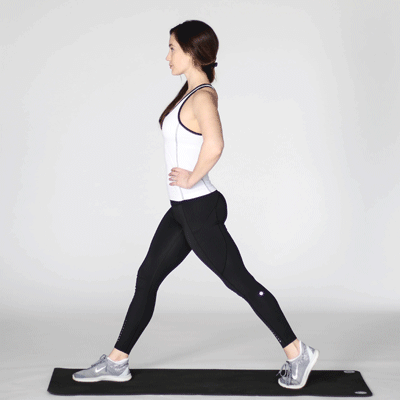
The basic lunge targets lower-body muscles, including quadriceps, hamstrings, glutes, and calves.
How to do it:
- Stand tall with feet about shoulder-width apart.
- Step forward with your right foot and lower your hips until your right thigh is roughly parallel to the floor and your left knee is near the ground. Avoid letting the front knee extend past your toes.
- Lengthen your spine to keep your torso upright.
- Hold the position for about 5 seconds or longer.
- Step the right foot back to meet the left, then repeat on the left leg.
- Do 10–12 reps per leg, rest, then complete another set.
Variations include walking lunges, jumping lunges, lunges with a torso twist, and side lunges.
Squat to overhead raise
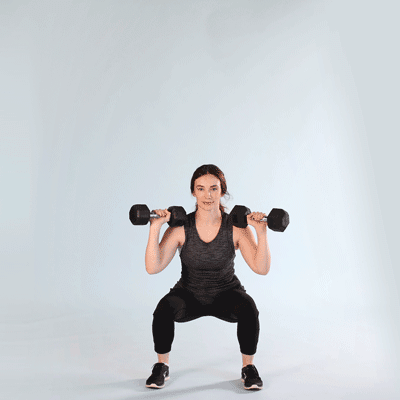
Beginners should start by raising the arms overhead without weights. Once your form is solid, add light dumbbells and gradually increase weight as your strength improves.
This move works your glutes and legs, and also engages core, back, shoulder, and triceps muscles.
How to do it:
- Stand with feet slightly wider than hip-width and arms at your sides.
- Slowly lower into a squat position.
- Press up to stand and lift your arms overhead.
- Return to the starting stance.
- Perform 1–3 sets of 8–12 reps.
Planks

Planks are excellent for building core strength and stability. They also engage muscles in the back, chest, and shoulders.
How to do it:
- Support your weight on your forearms and toes, keeping your body in a straight line with glutes tightened and abs engaged.
- Hold for about 30 seconds. If that’s too challenging, begin with 20 seconds.
- As you progress, aim to hold the plank for 1 minute or longer.
To increase difficulty, lift one leg at a time while maintaining the plank position.
Pushups
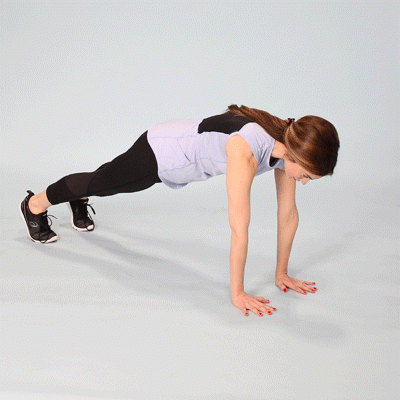
Traditional pushups target the chest (pectorals), shoulders, triceps, and abdominals.
How to do it:
- Begin in a plank position with hands under your shoulders.
- With a flat back and braced core, lower your body by bending your elbows until your chest nearly touches the floor.
- Push back up to the start.
- Repeat 8–12 times. Start with 1–2 sets and work up to 3 sets as you gain strength.
An easier modification is to place your knees on the floor instead of your toes. Harder variations include plyo pushups, close-grip pushups, and decline pushups.
Free weight exercises
The next two exercises use dumbbells. Begin with 5-pound weights; as you get stronger, move to 8- or 10-pound dumbbells.
You can substitute canned goods or water bottles if you don’t have dumbbells—just hold them securely to prevent slipping.
Dumbbell shoulder press
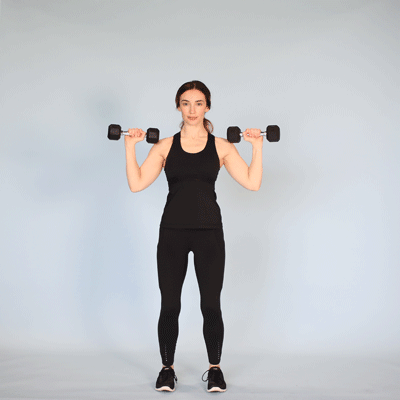
This move targets shoulder and arm muscles and also engages your core and chest.
How to do it:
- Stand with feet shoulder-width apart.
- Lift the dumbbells to shoulder level. Palms may face forward or inward.
- Press the weights overhead until your arms are extended.
- Pause briefly, then lower the dumbbells back to shoulder height.
- Perform 1–3 sets of 8–12 reps.
Dumbbell triceps kickback
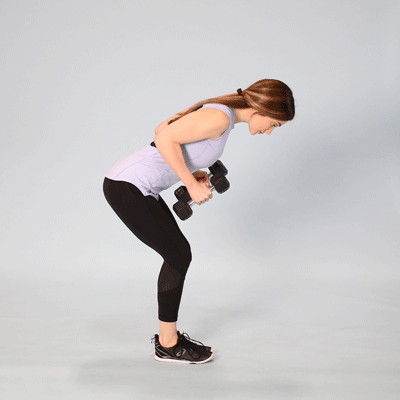
This exercise targets the triceps and also works the shoulders.
How to do it:
- Hold a dumbbell in each hand.
- Bend forward at about a 45-degree angle and bend your elbows to 90 degrees.
- Straighten your arms behind you, contracting the triceps as you extend.
- You can perform the move one arm at a time or both at once.
- If you’re a beginner, start with 1–2 sets of 8–12 reps and progress to 3 sets as strength improves.
Resistance band exercises
Resistance bands are lightweight, portable, and versatile. Research shows they can activate muscles similarly to free weights or machines.
Resistance band pull apart

This move targets muscles in the back, shoulders, and arms.
How to do it:
- Stand with arms extended in front of you at chest height.
- Hold a resistance band taut with both hands, keeping it parallel to the floor.
- With arms straight, pull the band outward toward your sides, initiating the movement from the mid-back.
- Squeeze your shoulder blades together, keep a neutral spine, then slowly return to start.
- Do 1–3 sets of 15–20 reps.
Hip extension
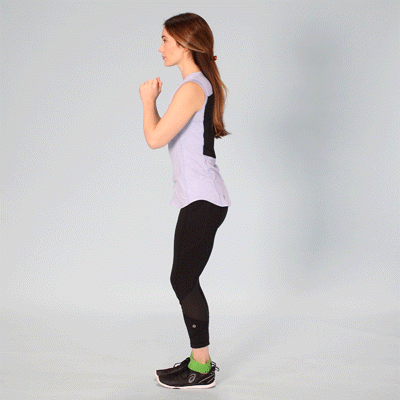
This exercise strengthens the hips and leg muscles. Use a light-to-medium resistance band.
- Loop the band around both ankles. Use a chair or wall for balance if needed.
- Keeping your body aligned, pull your left leg back as far as possible while keeping it straight.
- Return slowly to the starting position.
- Do 12 reps with the left leg, then switch to the right.
- Begin with 2 sets per side and build up to 3 sets as you gain strength.
Resistance band leg press
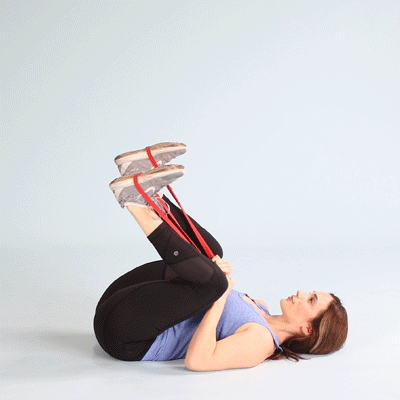
This move targets quadriceps, hamstrings, calves, and glutes. Similar to a machine leg press, it has you work against resistance.
- Lie on your back and lift your feet off the floor.
- Bend your knees to about 90 degrees and flex your feet so toes point up.
- Wrap the band around your feet and hold the ends in your hands.
- Press your feet against the band until your legs are straight.
- Bend your knees to return to the 90-degree starting position.
- Do 1–3 sets of 10–12 reps.
Cool down
End your session with a 5 to 10-minute cool down to let your breathing and heart rate return toward resting levels. Options include marching in place and gentle stretching.
The bottom line
Performing 30 to 45 minutes of strength training two to three times weekly is a great strategy for building lean muscle, burning calories, and increasing metabolism—factors that help reduce body fat and support weight loss.
Strength training also reinforces bones and joints, lowers the risk of chronic illnesses, enhances flexibility, posture, and balance, and raises mood and energy.
Many strength moves can be performed at home using bodyweight or inexpensive equipment for resistance.
If you have medical issues or an injury that makes exercise difficult, consult your physician or a certified personal trainer before beginning an at-home strength program.

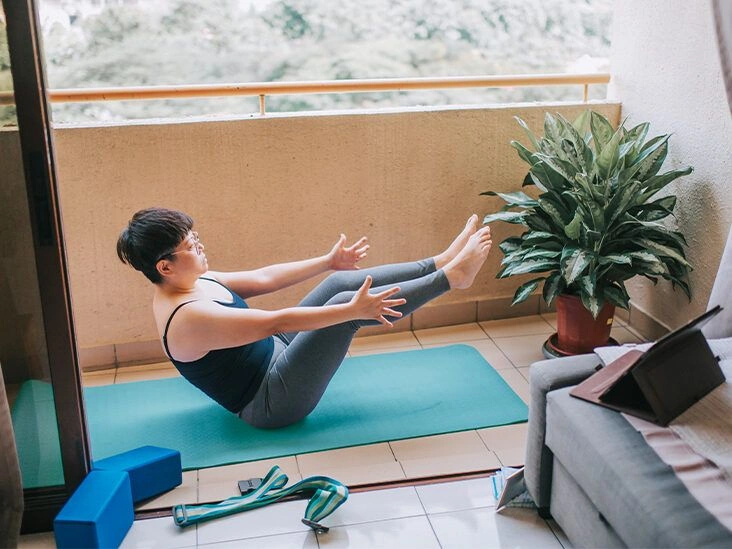
















Leave a Reply
You must be logged in to post a comment.